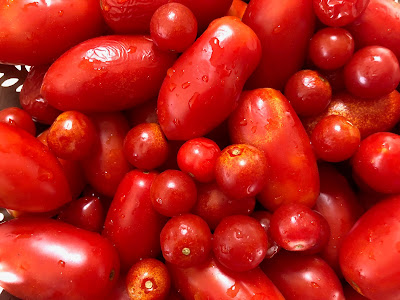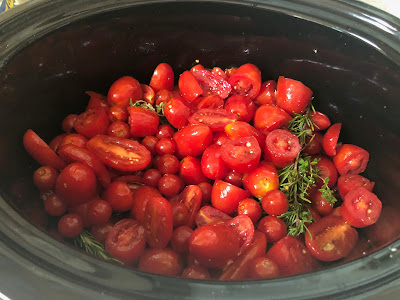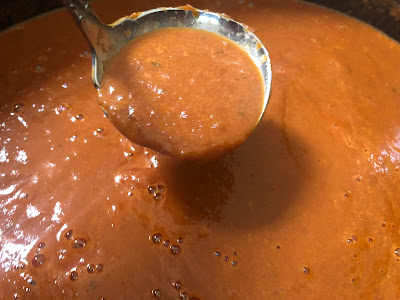
Recipe: Sauce or compote? It all depends

Meaty Juliets and smaller cherry tomatoes-- all
homegrown -- go into this slow-cooked recipe. (Photos: Kathy Morrison)
|
Not every recipe is going to turn out the way it says it will. That's just the way cooking goes -- lots of variables, including the equipment, ingredients and the cook's personal taste. But I like improvising in the kitchen, so if a result is not what I expected, I work to turn it into something I can use.
Thus, the slow-cooked cherry tomato compote I started that became a luscious slow-cooked tomato sauce. It's probably going to star in dinner tonight in a pasta and chicken dish, but I also could freeze it for later this year.
What I started with was a New York Times Cooking recipe from last month. It uses 2 pounds of cherry tomatoes, which I didn't have at the time, but do now. The recently harvested Juliet tomatoes, collected in a big salad bowl, alone weighed over 2 pounds, so I was set. Then I decided to add enough small cherry tomatoes to make 3 pounds, upping the recipe accordingly.
All those went into my 6-quart slow cooker, along with the balsamic vinegar and other ingredients. I decided to use fresh thyme and fresh rosemary from my garden for the herbs.
So ... after the 6-hour cooking time ended just before bedtime, the tomatoes were still very red -- the little cherries all puffed out -- and they were all swimming in a LOT of liquid. And that's having used the meaty Juliets. What am I going to use this odd concoction for? (I've since thought of some uses, figures.) I pulled out the herb sprigs (more on that below) and decided to turn the slow cooker down to "warm" and keep it going all night, just to see if things would improve.
In the morning, the color had turned to dark red, and the smell was heavenly. But so many tomato skins! But my secret weapon for cooked tomato skins is my immersion blender. A regular blender works, too. Blended that compote mostly smooth, and now it's a lovely sauce. Recipe transformed!
Note on herbs: If you want to use rosemary, as I did, do not put the whole sprigs in the sauce. You'll wind up with many loose prickly rosemary leaves that are not fun to eat. The immersion blender took care of some of that, and if I wanted to strain the sauce I could get them all out. But next time I make this, I'll strip the leaves from the stems first and chop them before adding to the slow cooker.
The thyme sprigs, by the way, were fine -- those leaves are tiny enough to blend in.
Slow-cooker cherry tomato compote or sauce
Makes about 5-1/2 cups
Ingredients:
3 pounds cherry or grape tomatoes (roughly 7 cups, depending on the variety)
4 to 6 garlic cloves, smashed
1/2 cup extra virgin olive oil
1-1/2 tablespoons honey or agave nectar
3 tablespoons balsamic vinegar
2 or 3 bushy sprigs fresh herbs, such as thyme, parsley, rosemary (see note above), tarragon, sage or a mix
1/2 teaspoon red-pepper flakes
Kosher salt and freshly ground black pepper
Juice of 1/2 lemon

The ingredients are ready to cook. See those rosemary sprigs?
They became a problem.
|
Instructions:
Place tomatoes, garlic, olive oil, honey, balsamic vinegar, herbs and red pepper flakes in the slow cooker. (Larger grape tomatoes like Juliets can be halved before cooking.) Sprinkle 2 teaspoons salt and several grinds of black pepper over the ingredients, and stir to blend.
Cook for 6 hours on low, until the tomatoes are very soft. Remove the herb stalks.
At this point, you can remove the mixture from the slow cooker, stir in the lemon juice, and refrigerate to use as a savory compote the next day. I could see it poured over polenta, for example, or the tomatoes pulled out and served with a burrata cheese ball and bread slices.
If you want to make sauce, turn the slow cooker down to warm (or, if yours doesn't have that setting, keep it on low) and continue cooking for 8 to 10 hours. By this point, the tomatoes will be dark red and the mixture a little thicker. Stir in the lemon juice, and then blend all or part of the mixture (depending on the texture desired) using an immersion blender or regular stand blender. Taste and adjust seasoning with salt and pepper if needed.

All blended, the sauce has a lovely creamy texture,
with some help from the olive oil in the recipe.
|
Use immediately, or refrigerate for a few days, or pack into freezer-safe containers and freeze for later use.
Comments
0 comments have been posted.Sacramento Digs Gardening to your inbox.
Sites We Like
Garden Checklist for week of July 21
Your garden needs you!
* Keep your vegetable garden watered, mulched and weeded. Water before 8 a.m. to reduce the chance of fungal infection and to conserve moisture.
* Feed vegetable plants bone meal, rock phosphate or other fertilizers high in phosphate to stimulate more blooms and fruiting. (But wait until daily high temperatures drop out of the 100s.)
* Don’t let tomatoes wilt or dry out completely. Give tomatoes a deep watering two to three times a week.
* Harvest vegetables promptly to encourage plants to produce more. Squash especially tends to grow rapidly in hot weather. Keep an eye on zucchini.
* Pinch back chrysanthemums for bushy plants and more flowers in September.
* Remove spent flowers from roses, daylilies and other bloomers as they finish flowering.
* Pinch off blooms from basil so the plant will grow more leaves.
* Cut back lavender after flowering to promote a second bloom.
* It's not too late to add a splash of color. Plant petunias, snapdragons, zinnias and marigolds.
* From seed, plant corn, pumpkins, radishes, winter squash and sunflowers.